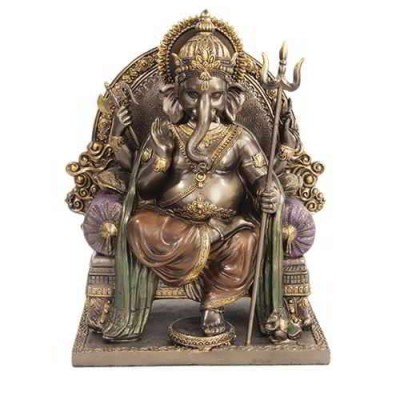Ganesha: A Comprehensive Insight into the Elephant-Headed Deity From Birth to Teachings
- Lori Anne Brown
- |
- Posted on: 2023-08-20
- |
- Views: 1410
- |
- Category:
- ▸ Gods and Goddesses
The Birth and Origin of Ganesha
Creation of a Unique Deity
The birth of Ganesha, the Lord of Success and Remover of Obstacles, unfolds in the dramatic interplay between divine entities. Ganesha's elephant head distinguishes him not only in appearance but also in symbolism. This remarkable form began with his creation by Goddess Parvati and the subsequent intervention by Lord Shiva.
In a dramatic event, Lord Shiva decapitates the young Ganesha, only to replace the head with that of an elephant. This event signifies a profound connection to wisdom, intellect, and discernment.
Variations of the Tale
The story of Ganesha's birth also offers another interpretation where Lord Shani's powerful gaze severs the child's head, leading to an elephant replacement. Such variations in the tale enrich the understanding of Ganesha's connection to intellect and wisdom.
Understanding the Names: Ganesh or Ganesha?
The two spellings, Ganesh and Ganesha, represent the cultural nuances of Northern and Southern India respectively. While both are correct, the meanings differ slightly.
- Ganesh: Predominantly used in Northern India, symbolizing “lord of the multitudes” or “lord of the people.”
Ganesha: Preferred in Southern India, meaning “lord of the ganas” or “lord of the categories,” referencing Lord Shiva's followers, the ganas.
How Ganesha Got His Elephant Head: A Transformative Myth
The well-known myth of Ganesha acquiring his elephant head is a profound tale of transformation. In an act to guard her home, Goddess Parvati creates a boy from dirt. Lord Shiva, denied access, decapitates the boy in anger. Realizing his error, Shiva commands his warriors to find a replacement head, resulting in the attachment of an elephant's head.
This transformation signifies Ganesha's rise to prominence and reverence within the pantheon of Hindu deities.
Ganesha and His Cosmic Interaction: The Moon Incident
A delightful interaction with the moon, Chandra Deva, illustrates Ganesha's playful yet impactful influence on the cosmos. Known for his love of sweets, Ganesha's overindulgence leads to a stumble, causing the moon to laugh. Ganesha's curse subsequently alters the moon's appearance forever.
The Symbolism of Ganesha: Wisdom, Humility, and More
Ganesha's physical attributes each carry significant symbolic meanings:
- Elephant Head: Wisdom, intelligence, and discernment.
- Broken Tusk: Sacrifice and overcoming dualism.
- Oversized Ears: Wisdom and empathy.
- Curved Trunk: Flexibility, adaptability, and intellectual potential.
- Pot Belly: Nature, equanimity, and infinite capacity.
- Four Arms: Complexity of human nature, representing mind, intellect, ego, and conscience.
- Mouse Ride: Mastery over desires, symbolizing humbleness.
- Axe and Prasad: Detachment from materialism and the essence of sharing and giving.
- These symbols collectively reveal a deity of profound complexity and philosophical guidance.
Ganesha's Worship: Crossing Boundaries of Time and Culture
In Hinduism
Ganesha's deep rootsin Hinduism establish him as a symbol of intellect, wisdom, and success. His worship transcends sectarian divisions, and his followers, known as Ganapatyas, are found across all Hindu sects.
Beyond Indian Borders
The universal appeal of Ganesha's teachings extends his worship to Southeast Asia, including Indonesia, Thailand, and Cambodia. His role as the Remover of Obstacles continues to inspire across cultural and religious boundaries.
Modern and Contemporary Practices
Ganesha's image as a harbinger of success finds resonance in modern practices, from business ventures to housewarming gifts. Celebrations like Ganesh Chaturthi and daily rituals continue to foster a connection to his teachings.
Why Ganesha Continues to Resonate
People pray to Ganesha to remove obstacles, clear paths to success, and even seek assistance with environmental challenges. His teachings offer wisdom, humility, resilience, adaptability, and compassion.
The Moral of Ganesha
- Wisdom and Intellect: Emphasizing discernment and understanding.
- Overcoming Obstacles: Encouraging resilience, creativity, and innovation.
- Humility and Compassion: Treating all with respect and kindness.
- Balance and Moderation: Teaching the importance of equilibrium in life.
In his rich and multifaceted mythology, Ganesha stands as a beacon of wisdom, success, and new beginnings. Through stories, symbols, and practices, his teachings continue to guide, inspire, and resonate with people across generations and cultures. His embodiment of human nature's complexity and spiritual pursuit offers a unique perspective on enlightenment and personal growth. Ganesha's presence in art, culture, and daily life reinforces his enduring relevance and universal appeal.
========================
Shop all Ganesha items on our shop now.




